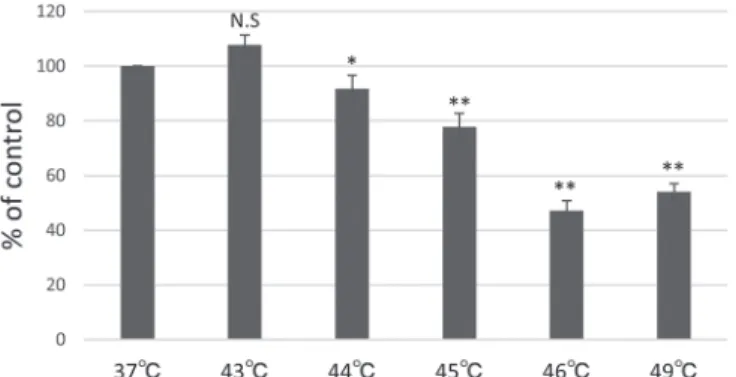2021 The Hard Tissue Biology Network Association
Printed in Japan, All rights reserved.
CODEN-JHTBFF, ISSN 1341-7649
Original
Expression of Heat Shock Proteins in Response to Mild Short-term Heat Shock in Human Deciduous Dental Pulp Fibroblast-like Cells
Sho Aoki
1), Kyoko Harada
2), Saki Kawai
2), Yoko Abe
2), Sachiko Nagata
2), Rie Imataki
2) and Kenji Arita
2)
1)
Graduate School of Dentistry, Department of Pediatric Dentistry, Osaka Dental University, Osaka, Japan
2)
Department of Pediatric Dentistry, School of Dentistry, Osaka Dental University, Osaka, Japan (Accepted for publication, October 22, 2020)
Abstract: Appropriate heat shock results in the production of heat shock proteins (HSPs) whose expression and phosphoryl- ation contribute to repair of damaged proteins, cell proliferation, and cell recovery from shock stimuli. However, there is no information regarding the expression of HSPs in human deciduous dental pulp fibroblast-like cells (hDDPF) in response to mild short-term heat shock. The aim of this study was to investigate the cellular effects of mild short-term heat shock on hDDPF. Cells were subjected to heat shock at 43°C–49°C for 15 min, and cell proliferation was assessed by 3-(4,5-dimeth- ylthiazol-2yl)-5-(3-carboxymethoxyphenyl)-2-(4-sulfophenyl)-2H-tetrazolium assay. mRNA and protein expressions of HSP27, 70, and 90 were detected by reverse transcription PCR and western blot analysis, respectively. Phosphorylation of the AKT and ERK signaling pathways of HSP production was evaluated by western blotting. Heat shock at 43°C for 15 min increased the cell proliferation rate and the mRNA expressions of HSP27, 70, and 90 in hDDPF. Moreover, protein expres- sion of HSP70 was significantly enhanced 24 h after heat shock, and the phosphorylation of AKT was also confirmed. Be- cause HSP70 is critical in tissue repair and regeneration, mild short-term heat shock may enhance tissue repair in hDDPF.
Key words: Human deciduous dental pulp fibroblast-like cells, Heat shock proteins
Introduction
The dental pulp is a soft tissue capable of self-repair in response to various stimuli such as bacterial toxins, heat shock, and chemicals from restorative materials
1,2). Depending on the extent of stimuli, cells re- spond in various manners such as altering gene expression, triggering proliferation pathways, and activating cell death signaling pathways
3). The literature shows that prolonged and excessive heat shock exposure may damage dental pulp tissue, whereas mild heat shock is effective for cell protection, tissue repair, and tissue regeneration
4,5).
Heat shock results in the rapid production of heat shock proteins (HSPs) whose expression and phosphorylation contribute to the repair of damaged proteins, cell proliferation, and cell recovery from various shock stimuli
6,7). Based on their molecular sizes, HSPs are divided into several groups such as HSP27, HSP70, and HSP90. HSPs promote cell proliferation under shock conditions by renaturing denatured proteins, protecting shock-labile proteins, preventing protein aggregation (chap- erone function), and degrading damaged proteins (protease activity)
8,9).
Previous studies have demonstrated that heat shock at 42°C for 30 min not only induces HSP25 (the rodent homolog of HSP27) expression but also enhances the activity of alkaline phosphatase, an enzyme ex- pressed in the early stage of mineralization and is a marker of rat pulp cell viability
10,11). Furthermore, heat shock at 43°C for 45 min strongly upregulated HSP25 expression in an odontoblast-like cell line
12). Anoth- er study showed that heat shock at 42°C markedly induced HSP70 ex-
pression after 1 h in rat dental pulp cells and restored intercellular com- munication and alkaline phosphatase activity
13).
However, there is limited information regarding the expression of HSPs in human deciduous dental pulp fibroblast-like cells (hDDPF).
These cells are known to have a higher proliferation rate and larger pop- ulation than the dental pulp cells of permanent teeth
14). Therefore, hD- DPF may represent an ideal source of stem cells for the repair of dam- aged tooth structures, induction of bone regeneration, and treatment of neural tissue injuries or degenerative diseases
15). Consequently, main- taining a healthy deciduous dental pulp to the maximum possible extent is desirable to use it for regenerative medicine.
Due to their role in the repair of damaged proteins, it is possible that increasing the HSP expression would avoid dental procedures such as vital pulp amputation and pulpectomy if it is reversible pulpitis and re- sult in maintaining a healthy pulp via HSP expression
16). For practical clinical applications, dental pulp cells should be subjected to short-term heat shock. However, the majority of studies conducted till date report only the effects of long-term heat shock on dental pulp cells
17) and only a few have investigated the effects of short-term heat shock.
Therefore, this study was conducted with the principal objectives of determining whether short-term heat shock can induce HSP expression in hDDPF and, if so, investigating its mechanism.
Materials and Methods Cell culture
hDDPF were obtained from the noncarious deciduous incisor of four healthy patients with orthodontic reasons at Osaka Dental University Hospital. The teeth were placed in sterile 0.01 M phosphate-buffered sa- Correspondence to: Dr. Kyoko Harada, Department of Pediatric Dentistry
School of Dentistry, Osaka Dental University, 8-1 Kuzuha Hanazono-cho,
Hirakata, Osaka 573-1121, Japan; Tel: +81-72-864-3085; Fax: +81-72-864-
3185; E-mail: kyoko-w@cc.osaka-dent.ac.jp

